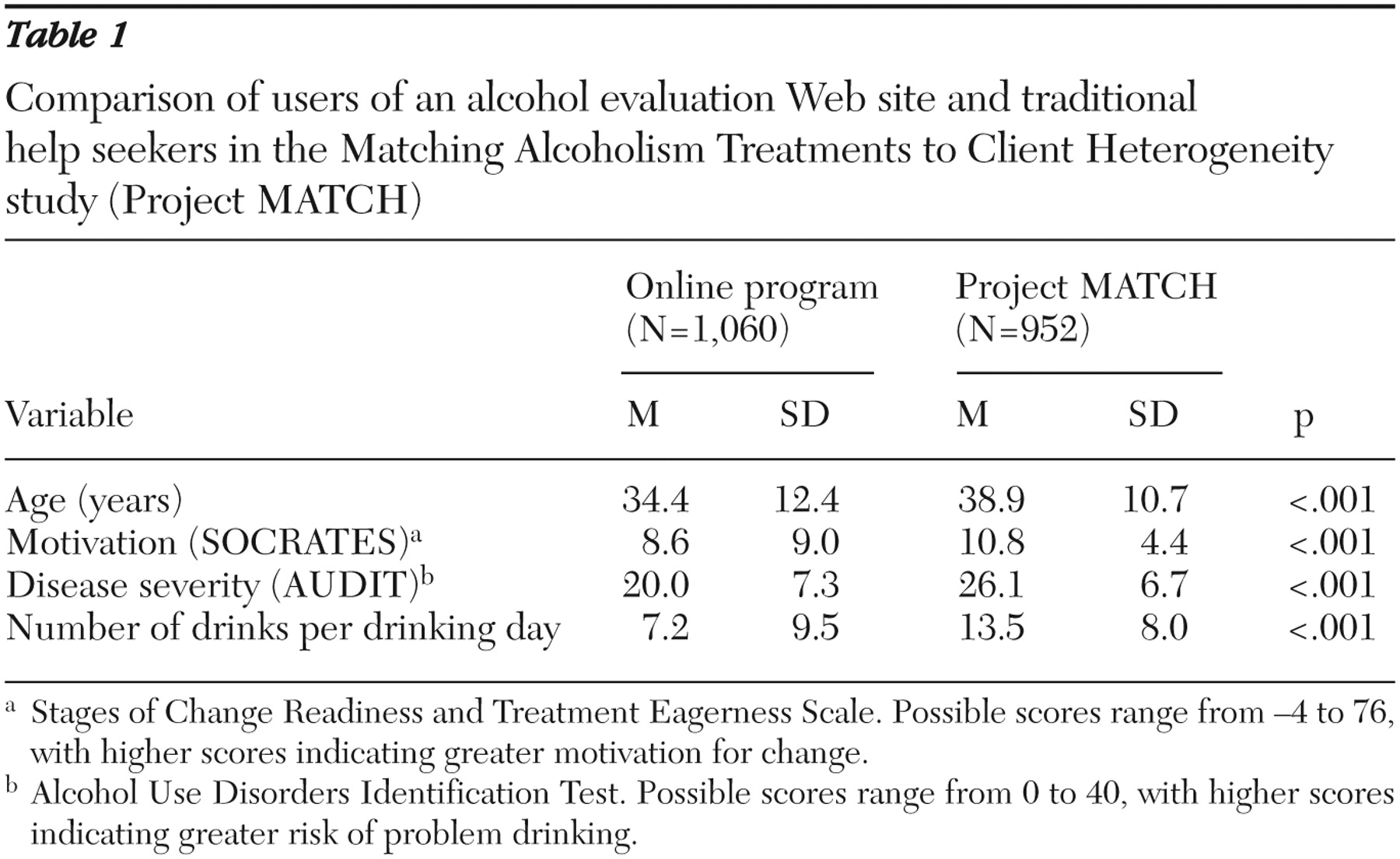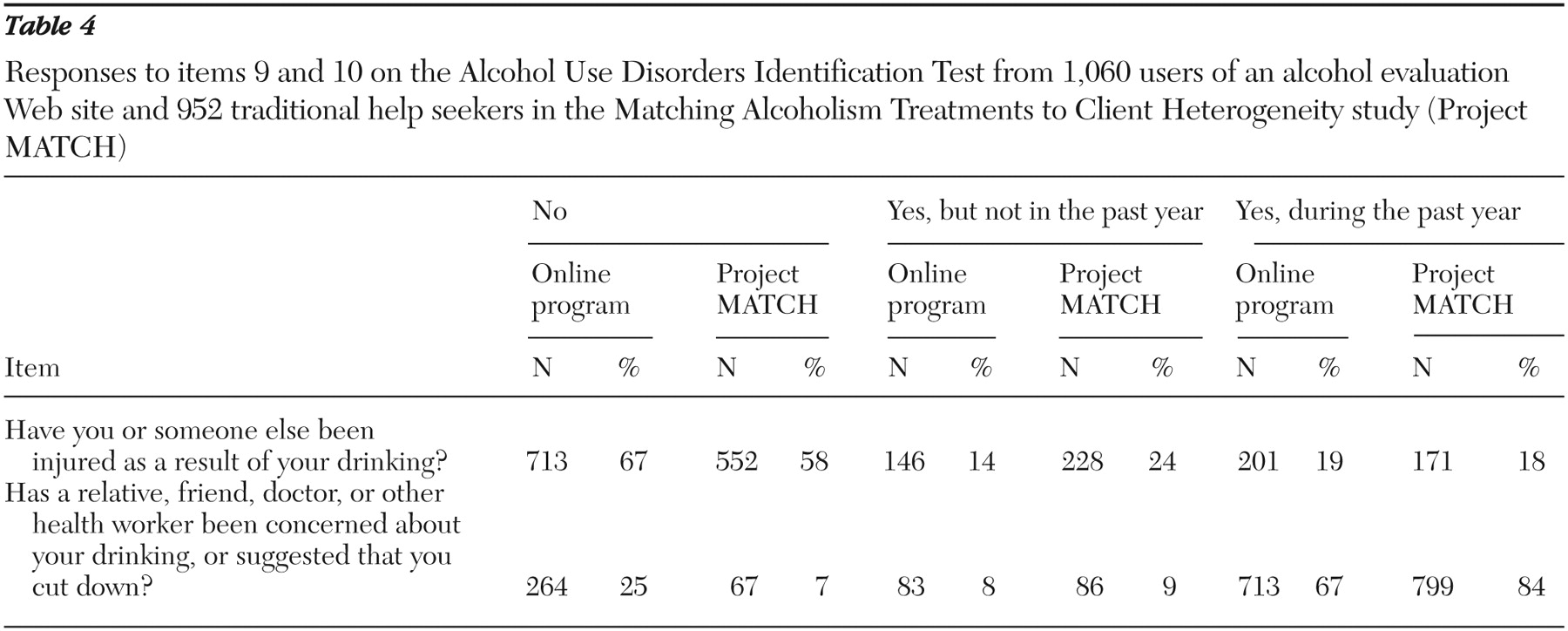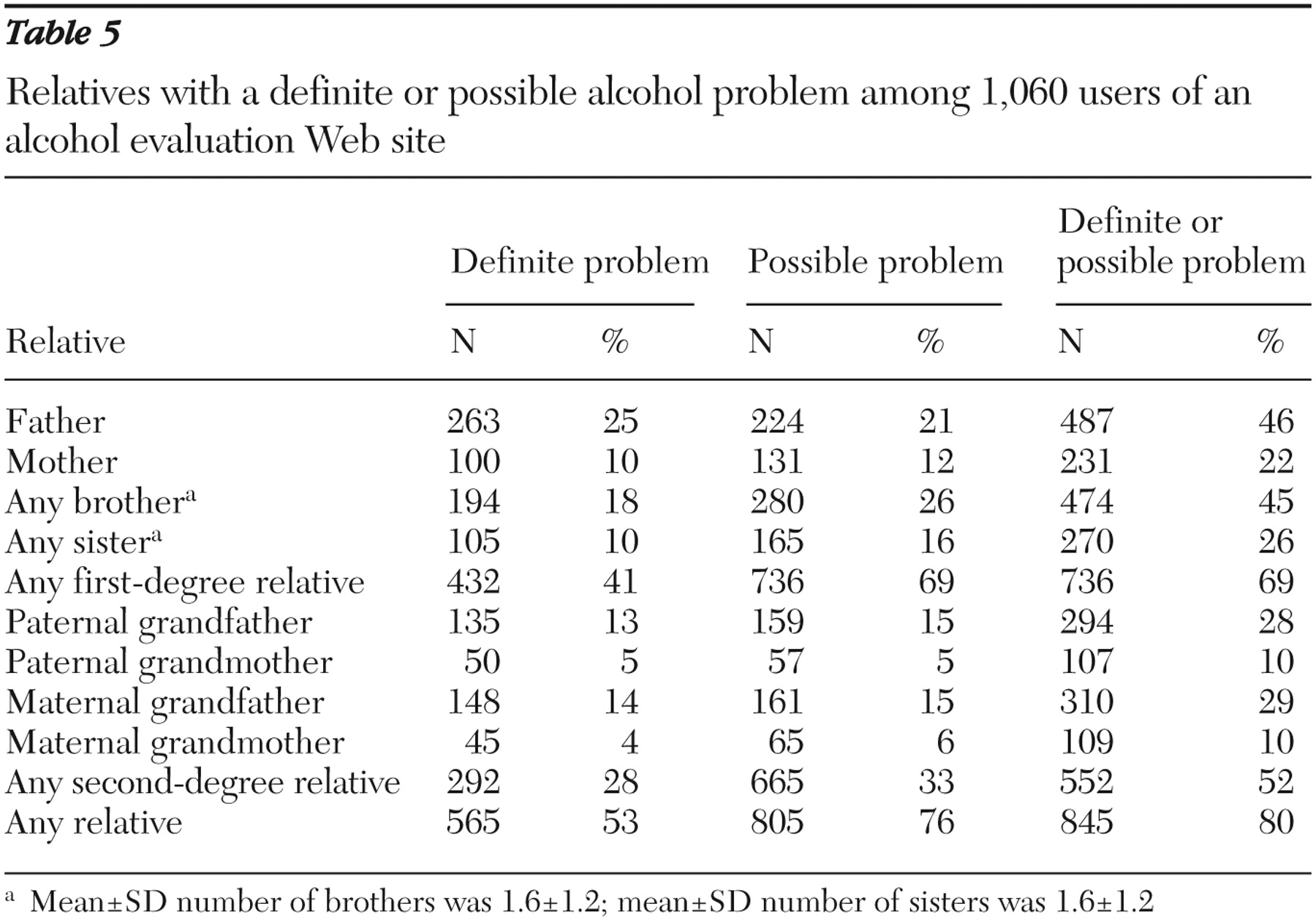Next to the development of new drugs and therapies, the greatest challenge to effective mental health treatment is successful engagement of patients. In the United States less than half of those in need receive care (
1 ), and treatment initiation is often delayed by a decade or more (
2 ). This problem is particularly apparent among those in need of alcohol treatment. In 2001 only 16% of those with an alcohol use disorder received professional treatment (
3 ).
Among the many factors that contribute to the undertreatment of alcohol use disorders, the most important and most difficult problem is a lack of desire for treatment. An analysis of the National Survey on Drug Use and Health data found that in a group of untreated alcohol abusers, only 2% perceived a need for treatment (
4 ). Even when appropriate services are available, it is difficult to convert problem drinkers into treatment seekers.
Innovative technological approaches have been used to increase access to treatment. Online therapy reduces obstacles related to geographical access and stigma. Patients can interact with a therapist regardless of their physical location, and they retain a higher degree of privacy. Online therapy was compared with traditional treatment in a group of alcoholics in the Netherlands. Using online therapy, a population of alcoholics was reached that was significantly different from patients engaging in face-to-face therapy (
5 ).
The development of automated interventions may also help to expand access to treatment. Because they do not require trained therapists, automated computer programs can be scaled upward to serve large numbers of people. A software program based on the Drinker's Check-Up (
6 ) that was designed to run on a stand-alone computer helped patients to decrease both the quantity and frequency of drinking by 50%, with gains maintained at the 12-month follow-up (
7 ).
Both of these studies recruited patients who were motivated to initiate some form of active intervention. The problem of reaching the majority of problem drinkers, who do not perceive a need for treatment, remains largely unaddressed. The study presented here reports on a program that was designed to run on a Web browser and was made available to the public over the Internet. Rather than recruiting patients with an interest in behavior change, this study enrolled Internet users who were seeking information on alcohol use and who found the program without having an expectation of modifying their drinking behavior.
Modeled on the aforementioned Drinker's Check-Up, this program offered a structured assessment that fulfilled users' desire for a better understanding of their alcohol use while exposing them to a type of intervention that has been found to increase motivation for change when used in traditional settings. The purpose of this study was to determine whether this strategy could deliver a motivational intervention to a group of problem drinkers who were significantly different from those who are served by existing forms of care.
Methods
Individuals with current drinking problems who accessed an Internet application designed to increase their motivation for change were compared with help-seeking patients who received treatment in traditional outpatient settings. The comparison group was derived from the public data set of the Matching Alcoholism Treatments to Client Heterogeneity study (Project MATCH). The Project MATCH study population was used as a control group because the patients in this study were specifically selected to be representative of individuals in the United States seeking treatment for an alcohol use disorder. Project MATCH recruited a total of 952 outpatients from nine treatment centers, representing a geographically diverse population of individuals seeking treatment in academic centers, community clinics, and private clinics (
8 ).
The Internet application was modeled on the Drinker's Check-Up, which is a component of motivational interviewing, a form of psychotherapy that facilitates behavior change (
9 ). The Drinker's Check-Up is a set of measures that helps a patient to see how alcohol consumption is negatively affecting his or her life, thereby increasing awareness of and concern about these consequences (
6 ). Intentionally imitating a physical check-up, it is nonjudgmental, nonthreatening, and objective. This type of approach allowed non-treatment-seeking drinkers to be recruited for the study.
An open-source application was developed to present the questionnaires and determine feedback. The source code is freely available for use and modification under a Creative Commons license (creativecommons.org/licenses/by-nc-sa/3.0) and can be obtained from the corresponding author. The application guided participants through a series of questionnaires, including the Stages of Change Readiness and Treatment Eagerness Scale (SOCRATES) (
10 ), the Alcohol Use Disorders Identification Test (AUDIT) (
11 ), the Family Tree Questionnaire (
12 ), and the Decisional Balance Questionnaire (
13 ).
The SOCRATES evaluates a patient's readiness to change in the context of the transtheoretical model of health behavior change (
14 ). Patients are scored on the basis of their recognition of having an alcohol problem, their level of concern about whether alcohol is having a negative effect on their lives, and the degree to which they have initiated behavior change. Possible scores range from -4 to 76, with higher scores indicating greater motivation for change.
The AUDIT is a ten-item questionnaire designed to distinguish light drinkers from those with harmful drinking. Originally intended for the early identification of harmful drinking, the screening instrument can also detect problem drinking with a high degree of accuracy (
15 ). Using a cutoff score of 8, the sensitivity to detect current drinking problems is 92% and the specificity is 94% (
16 ). The items included in the AUDIT were chosen to reflect three dimensions of drinking: alcohol intake (items 1–3); alcohol dependence, such as difficulty in controlling drinking, neglect of alternative interests, and physiological withdrawal (items 4–6); and adverse consequences (items 7–10). Possible scores range from 0 to 40, with higher scores indicating greater risk of problem drinking.
The Family Tree Questionnaire provides patients with a consistent set of cues for identifying blood relatives with alcohol problems by using a family tree diagram. Patients are asked to classify relatives into one of the following categories: never drank, social drinker, possible problem drinker, definite problem drinker, no relative (applicable only for siblings), or don't know or don't remember (
17 ).
Individuals who found the site spontaneously were eligible to participate in the study. This strategy allowed us to collect a sample of problem drinkers self-selected for some interest in learning more about their drinking. Inclusion criteria were broad. Study participants were required to have current drinking problems, as measured by an AUDIT score of 8 or more; have enough experience with the Internet to find the site; and have the ability to successfully navigate the simple user interface. Participants registered for the study anonymously. They did not provide any identifying information or personal health information as described in the Health Insurance Portability and Accountability Act. Internet Protocol (IP) addresses, which can be used to identify a user, were not recorded by the application. The possibility of a participant's anonymity being compromised by third-party monitoring was not addressed. Third-party monitoring can occur as a result of malicious "spyware" being surreptitiously installed on a user's computer or, more frequently, as a result of employers monitoring their employees' computer use at work.
Potential study participants were required to give informed consent by reading an information screen and agreeing to participate in the study. Written documentation of the informed consent process was waived because obtaining written informed consent while preserving anonymity by not collecting any identifying information would have created obstacles that would have made the study impossible to carry out. The study was approved by the George Washington University Institutional Review Board.
In order to determine whether the Internet application was able to reach a group that was distinct from the group of persons who access currently available treatment, the two groups were compared in terms of their age, level of motivation for change (SOCRATES), disease severity (AUDIT), and number of drinks consumed on an average day. The percentages of female participants and employed participants in the two populations were also compared.
Because all data from the Internet application were provided anonymously, the degree of correlation between certain variables was analyzed and compared with correlations found in previous studies of nonanonymous patients. Identifying similar correlations in the data collected via the Internet application would support the likelihood that the participants entered information with some degree of accuracy rather than capriciously. Relationships between the following variables were measured: age of initiation of alcohol use, age of initiation of problem drinking, number of drinks per drinking day, current severity of alcohol problems, and degree of recognition of alcohol-related problems.
Summary statistics are presented as means and standard deviations for continuous variables and percentages for discrete variables. Student's t tests were used to compare the characteristics of the online group and the traditional help-seeking group. Pearson's correlation was used to evaluate characteristics within the online group that have been found to be associated with one another.
Results
Over a period of 25 months, 1,455 individuals registered to use the online program, and 1,297 (89%) met the inclusion criteria of an AUDIT score of 8 or more. Of these, 1,060 (82%) completed the program and were included in the analysis.
Table 1 is for comparison of users of the program with patients enrolled in the outpatient arm of the Project MATCH study (N=952). Users of the online program were significantly younger, less motivated to change their drinking behavior, had lower scores on AUDIT, and drank fewer drinks per drinking day. In addition to using the global SOCRATES score to compare the level of motivation of the two groups, three subscales were evaluated individually: recognition of having a problem related to drinking, ambivalence about whether drinking is causing harm to oneself or others, and taking steps to make changes in alcohol use. Normative data in the form of decile rankings for these subscales are based on the Project MATCH treatment-seeking population (
18 ).
The mean recognition score of the online users was in the lowest decile. Individually, 71% (N=748) of the online users scored in the lowest decile, and only 5% (N=56) were in the fifth decile or higher. Examples of recognition statements from the SOCRATES include "I am a problem drinker" and "I really want to make changes in my drinking." The mean score for taking steps was also within the lowest decile. Individually, 85% (N=899) of the online users were in the lowest decile, and only 2% (N=23) were in the fifth decile or higher. An example of a taking steps statement is, "I'm not just thinking about changing my drinking, I'm already doing something about it."
Ambivalence scores were somewhat better. The mean ambivalence score was within the third decile. Only 11% (N=116) of the online group were in the lowest decile, and 32% (N=341) were in the fifth decile or higher. Although levels of ambivalence related to drinking were lower in the online group than in the help-seeking group, the scores were more comparable than the recognition or taking steps scores. An example of an ambivalence statement from the SOCRATES is "Sometimes I wonder if my drinking is hurting other people."
Tables
2,
3, and
4 show the individual items of the AUDIT for the online group and the Project MATCH group. The data are presented as the number of individuals in each group who selected each of the possible responses. The responses show that although the online group had lower scores than the help-seeking group, they still experienced a high degree of alcohol-related morbidity.
The online and traditional groups differed with respect to gender and employment status. Forty-seven percent of participants (N=500) in the online group were female, compared with 28% of those who participated in Project MATCH (N=264) ( χ 2 =19.7, df=1, p<.005). The Internet group contained a higher percentage of employed individuals—89% (N=943)—compared with 51% (N=486) in the Project MATCH group ( χ 2 =57.8, df=1, p<.005).
Descriptive data of users' family history of alcohol problems are shown in
Table 5 . Study participants reported high rates of definite or suspected alcohol problems among male first-degree relatives and lower rates among female relatives.
Findings that have been observed in other populations were tested in this population in order to help evaluate the validity of the data collected from anonymous study participants. Participants in the Internet group reported that they began drinking alcohol at a mean±SD age of 16.0±3.9 years and first began having a problem with alcohol at a mean age of 24.6±8.8 years. There was a high correlation between these two variables (r=.503, p<.001). The mean score on the AUDIT (20.0±7.3) was significantly associated with both the mean number of drinks per week (38.7±58.2) (r=.294, p<.001) and the mean score on the recognition subscale of the SOCRATES (22.0±7.0) (r=.568, p<.001). The number of drinks per week was also associated with higher scores on the recognition subscale (r=.121, p<.001). Contrary to other studies, the number of drinks per drinking day reported by men and women was not significantly different in the online group (7.3±2.2 for men versus 6.8±10.3 for women), although it was in the comparison population (14.4±8.2 for men versus 11.0±6.7 for women, p<.001). The total number of drinks per week reported by men using the online program was significantly greater than the number reported by women (40.2±33.3 for men versus 34.2±56.0 for women, p<.05).
Discussion
In order to connect with problem drinkers who do not access treatment, it is important to offer an intervention that has a low threshold of initiation, is easily accessible, is nonthreatening, and has no stigma attached to it (
19 ). Accessing a low-intensity intervention via the Internet fulfills these criteria well. The study program successfully attracted Internet users, and a large percentage who registered for the program completed it. Completion rates are important for a program that is designed to attract users as a source of information, while at the same time acting to increase internal motivation. Of the 1,297 users who registered for the program and had an AUDIT score greater than 8, the program was completed by 82%.
After users completed the assessment instruments, the negative consequences of their alcohol use were highlighted in the feedback they received. Unlike criticism initiated by others, which usually elicits resistance and defensiveness, the program provided feedback that was based on the participant's own report. Alcohol problems identified by a therapist or significant other may or may not be relevant to the problem drinker. By relying on the drinker's own report, the issues identified are more likely to have personal meaning.
Supporting the hypothesis that an online program of this type was able to reach a hidden population of non-treatment-seeking problem drinkers, participants had very low levels of recognition of their drinking problems and had not yet begun to take steps to change their behavior. This non-treatment-seeking population was younger and contained a larger proportion of females and employed individuals, compared with patients who received traditional treatment.
The finding of higher levels of employment in the online group may have been due to the flexibility of the program, which allowed it to be accessed without interfering with a work schedule. It may also reflect the ability of this program to reach alcohol abusers whose disease had not yet progressed to the point of job loss. Compared with traditional treatment seekers, who had a mean AUDIT score of 26, the online group appeared to be at an earlier stage of their illnesses. However, the mean AUDIT score of 20 indicated that there was nevertheless substantial morbidity associated with the online group's drinking. For example, 80% of the online group had experienced a blackout during the past year, and 33% reported an injury associated with their drinking. Similarly, although they averaged approximately seven drinks per drinking day, they drank less than the Project MATCH group, who reported drinking approximately twice as many drinks per drinking day.
A larger proportion of women accessed the online program, compared with the number who sought treatment at traditional facilities: 47% versus 28%. Despite the stereotype of the male computer enthusiast, a 2004 analysis by Nielsen/NetRatings found that women represented a higher proportion of Web users (
20 ). Depending on age, the analysis found that the percentage of women who used the Internet ranged from 63% to 78%. A similar study by the Pew Internet and American Life Project found that the number of American men and women on the Internet was about equal (68% of men and 66% of women) (
21 ). This study also found that women were more likely to look for health and medical information on the Internet and use Web sites to get support for health or personal problems. Because the prevalence of alcohol use disorders is approximately twice as great among men as among women (
22 ), women were underrepresented in the Project MATCH group and overrepresented in the online group.
Traditional substance abuse treatment programs do not adequately meet the needs of women owing to gender-specific barriers, which include lack of child care, lack of family treatment (women substance abusers are usually in relationships with other substance abusers), the threat of losing their children as a result of their substance abuse, and discomfort participating in male-dominated groups (
23 ). There is a need for treatment opportunities that better serve women with drinking problems.
Limitations of the data include uncertainty of the validity of information collected from anonymous participants. Lending credibility to the data, a number of correlations previously noted in other studies were confirmed in our analysis. For example, Hingson and colleagues (
24 ) found that persons who start to drink at an early age are more likely to develop alcohol dependence at younger ages, a relationship also observed in the data from the online group. The number of drinks consumed per day was significantly correlated with severity of alcohol-related problems and recognition of having an alcohol problem (
25,
26,
27 ). Men reported significantly more drinks per week than women, but the difference in the number of drinks per drinking day did not reach statistical significance. The manner in which the information was collected may have also affected the validity of the comparison to the Project MATCH population. It is possible that questionnaires that are designed to be completed anonymously via computer will elicit different information than those used in a traditional research setting.
The methodology of studying anonymous individuals over the Internet raised important ethical issues. In traditional face-to-face surveys, the researcher monitors respondent reactions and provides resources if a negative reaction occurs (
28 ). Because there was no way to identify the study participants, it would have been difficult to intervene in the event that one of the participants experienced a negative reaction while filling out the questionnaires. Each page on the Web site contained a "Contact Us" link that would allow a participant to send the principal investigator a message via e-mail. We were prepared to assist individuals to find appropriate care if they were willing to provide us with information on their location. None of the participants contacted us for this reason, and we received fewer than ten messages total. In each of them the sender wrote to express positive comments about his or her experience with the site. Additionally, the research questions asked were felt to represent no greater than minimal risk that would be unlikely to trigger strong emotional reactions.
All participants gave informed consent before participation in the study; however, documentation of the informed consent process was waived. The principal risks of the study were those associated with a breach of confidentiality. Because all aspects of the program were anonymous, it would have been necessary to develop a strategy to allow anonymous written informed consent in order to prevent the consent process from becoming the primary risk. The biggest obstacle would have been contacting individuals who sent in a consent form to tell them they could start the study. Preserving anonymity would preclude the collection of a name, address, telephone number, or e-mail address. It was suggested that this obstacle could have been overcome by asking interested individuals to mail a written consent under a pseudonym, and then monitor a Web site to see if their pseudonyms were posted as having approval to enter the study; however, we felt that this requirement would have impaired our ability to enroll participants to the point of making the study impossible.
Consequently, the consent process involved asking the user to read an information screen and indicate agreement or disagreement by clicking on the relevant button. An important disadvantage of this method is that it did not allow the investigators to verify understanding of the consent process through a face-to-face discussion. The information sheet was written to be simple to understand, and the length was kept to a minimum in order to encourage a thorough reading.
Although outcomes were not measured in this study, one would expect the effects of this type of intervention to be modest. Its benefits are derived from its breadth, rather than the magnitude of change effected. In contrast, the currently available health care system is designed to provide more intensive treatment to highly dependent drinkers, while presenting formidable barriers to treatment initiation. These barriers have contributed to the belief that drinkers need to "hit bottom" before they are willing to consider treatment. Although severely dependent drinkers have the greatest need for treatment, those with less serious illnesses make up the majority of problem drinkers and experience most of the alcohol-related harm (
29 ).
Rather than just focusing on the most severely ill patients, a stepped-care model provides a series of interventions that vary in intensity and difficulty of initiation (
30 ). An online program works well as an initial step because it is available on demand without regard to time or location. It can take advantage of an emerging interest in behavior change, even if that interest is fleeting. Although there may be substantial costs associated with the development of this kind of program, the marginal cost for each additional user is close to zero. Therefore it can realistically be offered for free.
On the basis of the data from the SOCRATES scale, few users who were attracted to this program by the easy accessibility and freedom from commitment had a clear intention of changing their drinking patterns. Nevertheless, simple exposure to the program may have been beneficial. Participation alone can be enough to provide an effective intervention, even among poorly motivated individuals (
31 ).
Conclusions
The online program was able to reach a distinct population of non-treatment-seeking problem drinkers. Whether the low-intensity intervention was able to increase motivation, change behavior, or facilitate treatment seeking will require further study. Despite the fact that levels of problem recognition and actual change behavior ranked at the very bottom of the decile scale, concern about the harm of alcohol use was comparable to that of traditional treatment-seekers. The presence of significant ambivalence suggests that a window of opportunity exists and that these individuals may be well positioned for an intervention that can tip the decisional balance in favor of change.
Acknowledgments and disclosures
The preparation of this article was supported in part by a grant from the Dalio Family Foundation.
The authors report no competing interests.






